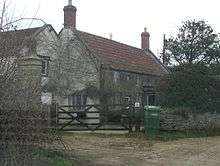Babington, Somerset
Babington is a small village between Radstock and Frome, Somerset, England, which has now largely disappeared.
| Babington | |
|---|---|
 Babington Location within Somerset | |
| OS grid reference | ST706510 |
| Civil parish |
|
| District | |
| Shire county | |
| Region | |
| Country | England |
| Sovereign state | United Kingdom |
| Post town | BATH |
| Postcode district | BA3 |
| Police | Avon and Somerset |
| Fire | Devon and Somerset |
| Ambulance | South Western |
| UK Parliament | |
History
In 1233 or 1234 much of the southern area of what is now Babington Parish was granted to the Knights Templar and became known as Temple Newbury. It consisted of around four Virgates and may have supported cloth making and fulling mills.[1]
The parish of Babington was part of the Kilmersdon Hundred,[2]
The village dates from medieval times. Its name derives from the Babington family, who were once associated with the village,[3] but appears to have been largely demolished to make way for the manor house around 1705.[4] Evidence of the medieval village was found during excavations carried out in 1997.[5]
It is known that the manor was sold by Thomas and Mary Mankham to Joan Elcode, a widow, in a deed dated Easter 1572. The Manor then contained 7 messuages, one cottage, 10 tofts, 1 water mill, 10 gardens, 14 orchards, 300 acres (1,214,057 m2) of land, 120 acres (485,623 m2) of meadow, 160 acres (647,497 m2) of pasture, 20 acres (80,937 m2) of wood, 120 acres (485,623 m2) of furze and 4s annual rent and 1 lb of pepper.[6]
Babington House
The current Babington House was built around 1705 for Henry Mompesson, probably on the foundations of an earlier building. Babington was inherited by successive members of the Knatchbull family until 1952, when the House and immediate grounds were sold. In 2000, it was bought by the Soho House club, and converted to a hotel, club and wedding venue in 2000.[7]
The Georgian architecture house is designated by English Heritage as a Grade II* listed building.[8] The 18th-century stable block and coach house have now been made into three separate dwellings.[9] The grounds also contain a listed ice house[10] and two impressive sets of gates.[11][12]
Church of St Margaret
The church is thought to date from 1748 and was probably built by John Strahan or William Halfpenny, and is considered to be very similar in conception to Redland Chapel in Bristol which was long considered to be by John Strahan but now known to be by William Halfpenny. It is a Grade I listed building.[13] The interior includes an unusual Royal Arms of the Hanoverians on the Rood.[14]
The church is owned and operated by the St Margaret's, Babington, Charitable Trust, and is licensed for weddings and public worship. The Trust works in partnership with the management of Babington House, which is adjacent, to arrange weddings for Babington House clients in the church. The church is not exclusively for Babington House clients.[15]
Within the churchyard there are a set of three chest tombs. The monument to John Shute is dated 1688 and that to Thomas Branch 1779.[16]
Charity Cottage

Charity Cottage in Charity Lane dates from the 17th century and was built as three cottages, although they have now been converted into one property.[17]
References
- Faith, Juliet. The Knights Templar in Somerset. The History Press. pp. 42–58. ISBN 9780752452562.
- "Somerset Hundreds". GENUKI. Retrieved 16 October 2011.
- Copographica Genealogica, Vol VIII, John Bowyer Nichols and Son. BABINGTONIA.
- "Park, Babington House, Babington". Somerset Historic Environment Record. Archived from the original on 30 September 2007. Retrieved 3 September 2007.
- "Evaluation, Babington House (1997)". Somerset Historic Environment Record. Archived from the original on 30 September 2007. Retrieved 3 September 2007.
- "Deserted medieval village, Babington". Somerset Historic Environment Record. Archived from the original on 27 September 2007. Retrieved 3 September 2007.
- "Natasha Kaplinsky". Rex Features. Archived from the original on 27 September 2007. Retrieved 3 September 2007.
- Historic England. "Babington House (1177567)". National Heritage List for England. Retrieved 3 September 2007.
- Historic England. "Stables and coach house adjacent to Babington House (1058688)". National Heritage List for England. Retrieved 3 September 2007.
- Historic England. "Ice house in grounds to south-west of Babington House (1177612)". National Heritage List for England. Retrieved 3 September 2007.
- Historic England. "Gate piers and flanking walls with secondary piers at former driveway entrance to Babington House (1345117)". National Heritage List for England. Retrieved 3 September 2007.
- Historic England. "Pair of gate piers at former entrance to driveway to Babington House adjacent to Charity Cottage (1345079)". National Heritage List for England. Retrieved 3 September 2007.
- Historic England. "Church of St Margaret (1177624)". National Heritage List for England. Retrieved 3 September 2007.
- Reid, Robert Douglas (1979). Some buildings of Mendip. The Mendip Society. ISBN 0-905459-16-4.
- "St Margaret's Babington Charitable Trust". Charity Commission. Retrieved 28 December 2014.
- Historic England. "Group of three monuments to east of Church of St Margaret (1058689)". National Heritage List for England. Retrieved 3 September 2007.
- Historic England. "Charity Cottage (1177651)". National Heritage List for England. Retrieved 3 September 2007.
External links
| Wikimedia Commons has media related to Babington, Somerset. |